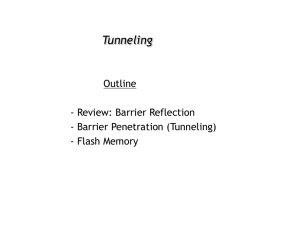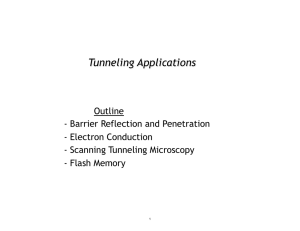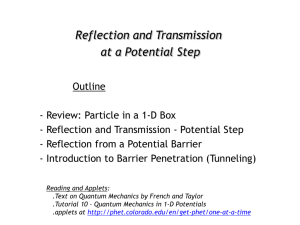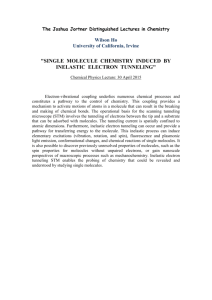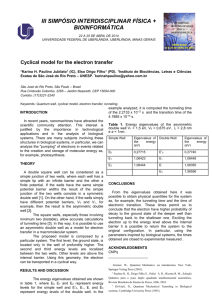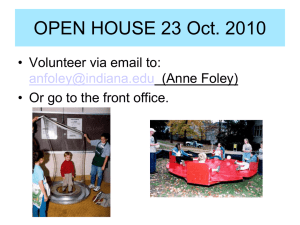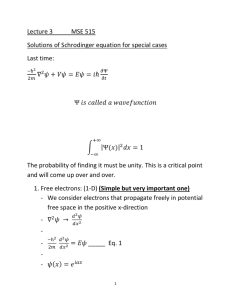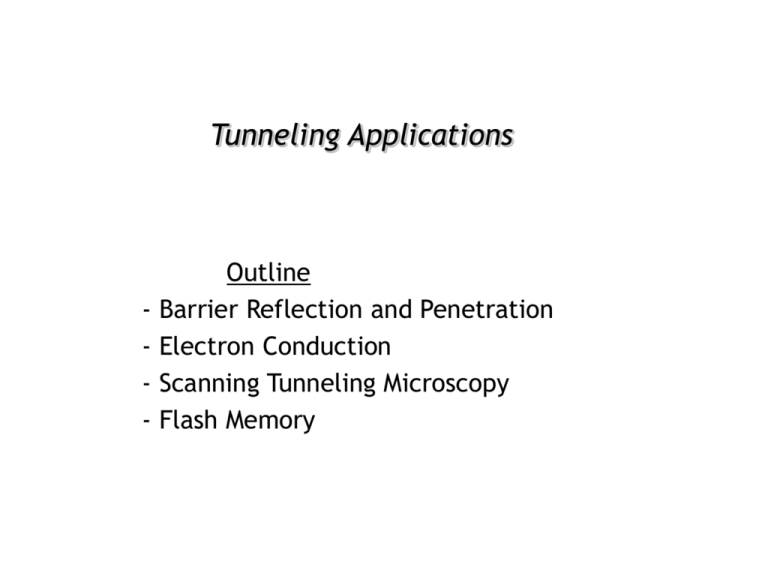
Tunneling Applications
-
Outline
Barrier Reflection and Penetration
Electron Conduction
Scanning Tunneling Microscopy
Flash Memory
Reflection of EM Waves and QM Waves
Then for optical material when μ=μ0:
= probability of a particular
photon being reflected
= probability of a particular
electron being reflected
Quantum Tunneling Through a Thin Potential Barrier
Total Reflection at Boundary
Frustrated Total Reflection (Tunneling)
2a = L
A Rectangular
Potential Step
CASE II : Eo < V
Region 1
In Regions 1 and 3:
In Region 2:
for Eo < V :
Region 2
Region 3
A Rectangular
Potential Step
2a = L
Real part of Ψ for Eo < V,
shows hyperbolic
(exponential) decay in the
barrier domain and decrease
in amplitude of the
transmitted wave.
x=0
x=L
for Eo < V :
Transmission Coefficient versus Eo/V
for barrier with
Tunneling Applet: http://www.colorado.edu/physics/phet/dev/quantum-tunneling/1.07.00/
Imagine the Roller Coaster ...
Start position with zero speed
A
B
• Normally, the car can only get as far as B,
before it falls back again
• But a fluctuation in energy could get it over the barrier to E!
• A particle ‘borrows’ an energy E to get over a barrier
• Does not violate the uncertainty principle,
provided this energy is repaid within a certain time t
Example: Barrier Tunneling
• Let’s consider a tunneling problem:
An electron with a total energy of Eo= 6 eV
approaches a potential barrier with a height of
V0 = 12 eV. If the width of the barrier is
L = 0.18 nm, what is the probability that the
electron will tunnel through the barrier?
V0
Eo
metal
metal
0 L air
gap
Question: What will T be if we double the width of the gap?
x
Multiple Choice Questions
Consider a particle tunneling through a barrier:
1. Which of the following will increase the
likelihood of tunneling?
a. decrease the height of the barrier
b. decrease the width of the barrier
c. decrease the mass of the particle
V
Eo
0 L
2. What is the energy of the particles that have successfully “escaped”?
a. < initial energy
b. = initial energy
c. > initial energy
Although the amplitude of the wave is smaller after the barrier, no
energy is lost in the tunneling process
x
Flash Memory
Stored
Electrons
Programmed
“0”
Erased
“1”
Image is in the public domain
CONTROL GATE
Tunnel Oxide
Insulating
Dielectric
Floating
Gate
FLOATING GATE
SOURCE
CHANNEL
Substrate
Electrons tunnel preferentially when a voltage is applied
DRAIN
Channel
MOSFET: Transistor in a Nutshell
Conduction electron flow
Control Gate
Conducting Channel
Image courtesy of J. Hoyt Group, EECS, MIT.
Photo by L. Gomez
Semiconductor
Image courtesy of J. Hoyt Group, EECS, MIT.
Photo by L. Gomez
Tunneling causes thin insulating layers
to become leaky !
Image is in the public domain
Reading Flash Memory
UNPROGRAMMED
PROGRAMMED
CONTROL GATE
CONTROL GATE
FLOATING GATE
FLOATING GATE
SILICON
To obtain the same channel charge, the programmed gate needs a
higher control-gate voltage than the unprogrammed gate
How do we WRITE Flash Memory ?
Reading Flash Memory
Reading a bit means:
1. Apply Vread on the control gate
2. Measure drain current Id of the
floating-gate transistors
Erasing Flash Memory
Fowler-Nordheim tunneling
Direct tunneling
Effective thickness decreases with voltage…
Flash Memory
Holding Information
Eo
Erasing Information
V0
Eo
channel
floating gate
floating gate
oxide
barrier
channel
oxide
barrier
x
0 L
Retention = the ability to hold on to the charge
Tunnel oxide
thickness
Time for 20%
charge loss
4.5 nm
4.4 minutes
5 nm
1 day
6 nm
½ - 6 years
Effective thickness
of the tunneling barrier
decreases, as the applied voltage
bends the potential energy levels
7-8 nm oxide thickness is the bare minimum, so that the flash memory chip
can retain charge in the floating gates for at least 20 years
x
Application of Tunneling:
Scanning Tunneling Microscopy (STM)
Due to the quantum effect of “barrier penetration,” the
electron density of a material extends beyond its surface:
material
One can exploit this
to measure the
electron density on a
material’s surface:
Sodium atoms
on metal:
STM tip
~ 1 nm
material
E0
STM tip
V
Single walled
carbon nanotube:
STM images
Image originally created
by IBM Corporation
© IBM Corporation. All rights reserved. This content is excluded from our Creative
Commons license. For more information, see http://ocw.mit.edu/fairuse.
Image is in the public domain
Leaky Particles
Due to “barrier penetration”, the electron density of a metal
actually extends outside the surface of the metal !
EVACUUM
Work
function Φ
EFERMI
Occupied levels
x
x
x=0
Assume that the work function (i.e., the energy difference between the most energetic
conduction electrons and the potential barrier at the surface) of a certain metal is Φ = 5 eV.
Estimate the distance x outside the surface of the metal at which the electron probability
density drops to 1/1000 of that just inside the metal.
(Note: in previous slides the thickness of the potential barrier was defined as x = 2a)
k
using
Application: Scanning Tunneling Microscopy
Piezoelectric Tube
With Electrodes
Metal
Vacuum
Metal
Vacuum
Second Metal
Tunneling
Current Amplifier
Tip
Sample
Tunneling
Voltage
Image originally created by IBM Corporation.
© IBM Corporation. All rights reserved. This content is excluded
from our Creative Commons license. For more information, see
http://ocw.mit.edu/fairuse.
Application of Tunneling:
Scanning Tunneling Microscopy (STM)
Due to the quantum effect of “barrier penetration,” the
electron density of a material extends beyond its surface:
material
One can exploit this
to measure the
electron density on a
material’s surface:
STM tip
~ 1 nm
material
STM tip
Sodium atoms
on metal:
E0
DNA Double
Helix:
V
STM images
Image originally created
by IBM Corporation.
© IBM Corporation. All rights reserved. This content is excluded
from our Creative Commons license. For more information, see
http://ocw.mit.edu/fairuse.
Image by Wolfgang Schonert
of GSI Biophysics Research Group
Courtesy of Wolfgang Schonert,
GSI. Used with permission.
“PRIMITIVE
or PLAIN”
“CHILD”
= “ATOM”
Images originally created by IBM Corporation.
© IBM Corporation. All rights reserved. This content is excluded from our Creative Commons
license. For more information, see http://ocw.mit.edu/fairuse.
E(x)
Example: Al wire contacts
“Everyday” problem:
You’re putting the electrical wiring in your new house,
and you’re considering using Aluminum wiring, which is
cheap and a good conductor. However, you also know
that aluminum tends to form an oxide surface layer (Al2O3)
which can be as much as several nanometers thick.
V0
10 eV
Eo
outlet
contact
Al wire
0 L
x
This oxide layer could cause a problem in making electrical
contacts with outlets, for example, since it presents a barrier of
roughly 10 eV to the flow of electrons in and out of the Al wire.
Your requirement is that your transmission coefficient across any
contact must be T > 10-10, or else the resistance will be too high
for the high currents you’re using, causing a fire risk.
Should you use aluminum wiring or not?
Compute L:
Oxide is thicker
than this, so go
with Cu wiring!
(Al wiring in
houses is illegal
for this reason)
Tunneling and Electrical Conduction
4
Squeezing a material can
reduce the width of the
tunneling barrier and turn an
‘insulator’ into a ‘metal’
Si
Ge
V0
log(resistivity)
2
metal
metal
0 L
0
-2
0
200
Pressure (kbar)
400
Eo
Polymer
x
gap
Key Takeaways
FOR EXAMPLE:
V0
Eo
metal
metal
0
L
air
gap
x
MIT OpenCourseWare
http://ocw.mit.edu
6.007 Electromagnetic Energy: From Motors to Lasers
Spring 2011
For information about citing these materials or our Terms of Use, visit: http://ocw.mit.edu/terms.

